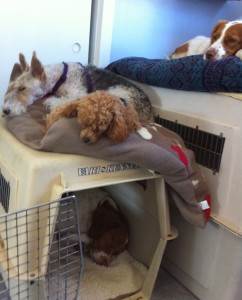Crates are fantastic tools when used correctly with dogs. A crate aids in housetraining a dog very quickly but more importantly, I believe, a crate helps you set up a new dog (of any age) to do the right thing. In a crate, your dog is confined to a space where he is physically restrained from doing the “wrong” behavior (chewing, peeing etc.) and can build habits of doing the “right” thing (chewing his own toys and not using the house for potty purposes). I advise clients to supervise or confine a new dog 24 hours a day so that they can prevent undesirable behaviors and set their dog up to succeed.
I am also a big fan of crates for dogs that live in homes with children. Not to keep the dog away from the kids but to keep the kids away from the dog! It is hugely helpful for a dog in a busy home to have his own space to get away and/or be comfortable and happy being put away when chaos ensues.
Crates can certainly be abused and must be used correctly. I do not like to see a dog in a crate for more than 4 hours at a time. It is important to introduce the crate to your dog with all associations around the crate being positive ones.
There is a lot of great information already out there on basic crate training so I will not go into that here. Definitely start with The Humane Society and PAWS websites. The book Way To Go by London/McConnell is also a good resource.
I want to add a few tips for problems I sometimes see clients having even after they have done the basics. So, in addition to the guidelines from the resources above, here are my tips:
- Do whatever you can to make the crate an AWESOME place for your dog to be – treats, meals and special toys may all be found in the crate! Maybe feed your dog’s meals in food stuff-able/puzzle toys or from a snuffle mat in the crate.
- Exercise your dog well before going into crate. Don’t try to crate your dog when he is excited or has not yet had his exercise needs met. Your dog should be tired and need a nap when crating.
- If your dog is destroying crate bedding try a flat mat. I like yoga mats or possibly a rubber backed bathmat. You may need to have no mat for a bit just to break the habit.
- Keep in mind that if the dog is destroying bedding you need to deal with the cause of the destruction – is he bored (need better toys in the crate)? Not exercised sufficiently prior to crating? Is he anxious? If this is an anxiety issue you need to deal with the anxiety separately. A dog should not be stressing out (vocalizing, trying to get out) in a crate. If your dog is destroying the crate (and possibly injuring himself) the answer is NOT to get a stronger crate, the answer is to relieve the dog’s stress and anxiety.
- Crate your dog when you are home and awake, not just when you leave or when you go to sleep. The crate can become an undesirable place if your dog only associates the crate with you leaving.
- Make sure the crate is in a space you “live” – not tucked away in a basement/garage etc.
- You may need to start with shorter time in the crate – 1 hour (or less), then 2, 3 etc. I recommend 4 hours maximum time in a crate (a dog under 18 weeks much less). If your dog needs to be left longer, she needs a walk or outing mid-day.
- Turn going in and out of the crate a fun game! Have dog go in crate (you may need to plant a treat in there to start) and when he does, mark (“yes” or click) and treat. Wire crates are great for this since you can toss the treat through the top. Then say “OK” in a happy tone and have him come out. Repeat several times. Likely, your dog will start to head in there on his own – that leads to mark/treat! Inside the crate, he gets a treat. Outside the crate = boring. You can shape this into him sitting then lying down in the crate before you mark/treat. You dog gets to try different behaviors and figure out which one gets him a mark/treat. You can use the same process as Go to Mat for going in the crate.
- Be careful not to lure your dog into the crate by coercing him with food. Your dog may “wise up” to this trick and will learn not to come near you or the crate when you have that delicious treat. This can really ruin that treat as a reward and your dog may learn not trust you. Instead, when you dog is not looking plant treats in the crate for him to randomly find when he wanders in.

